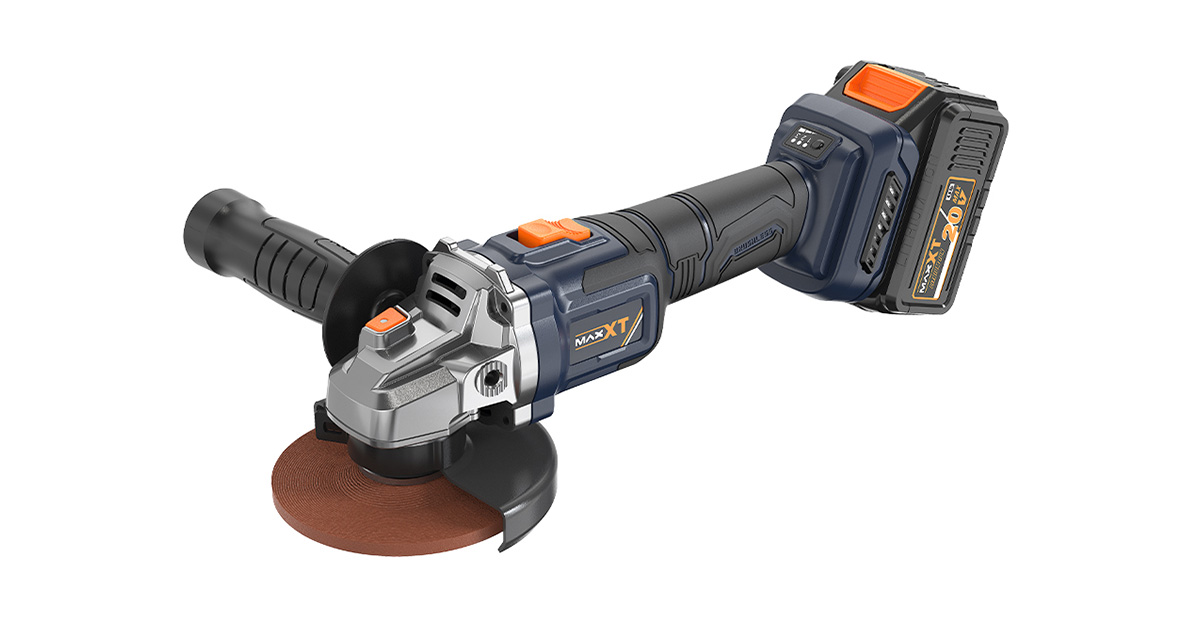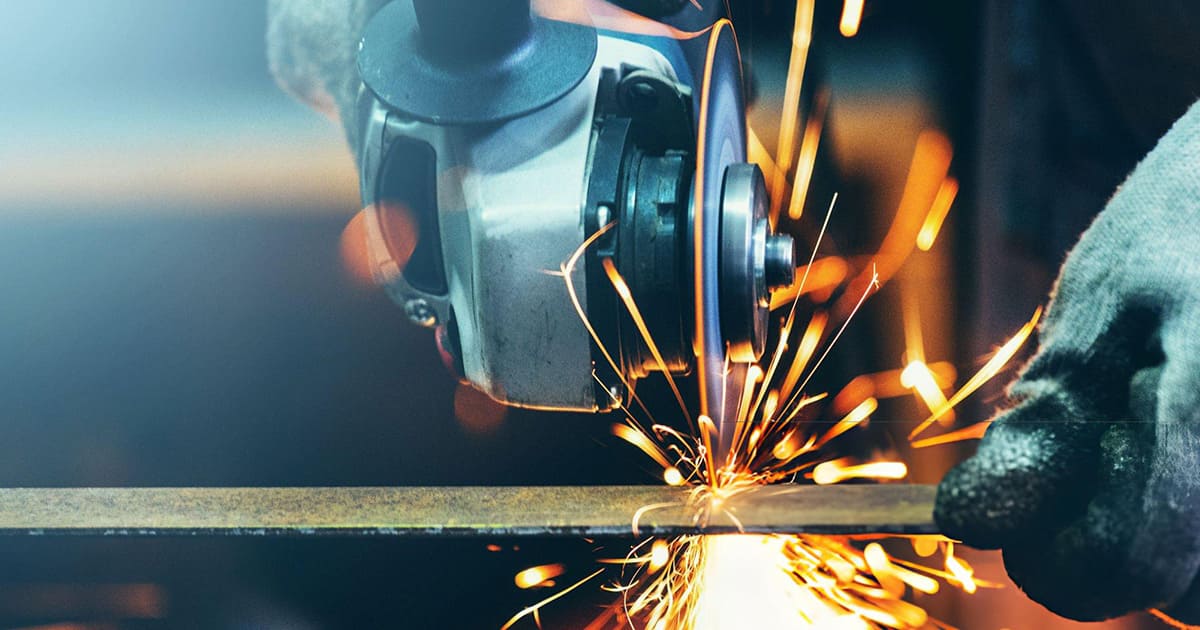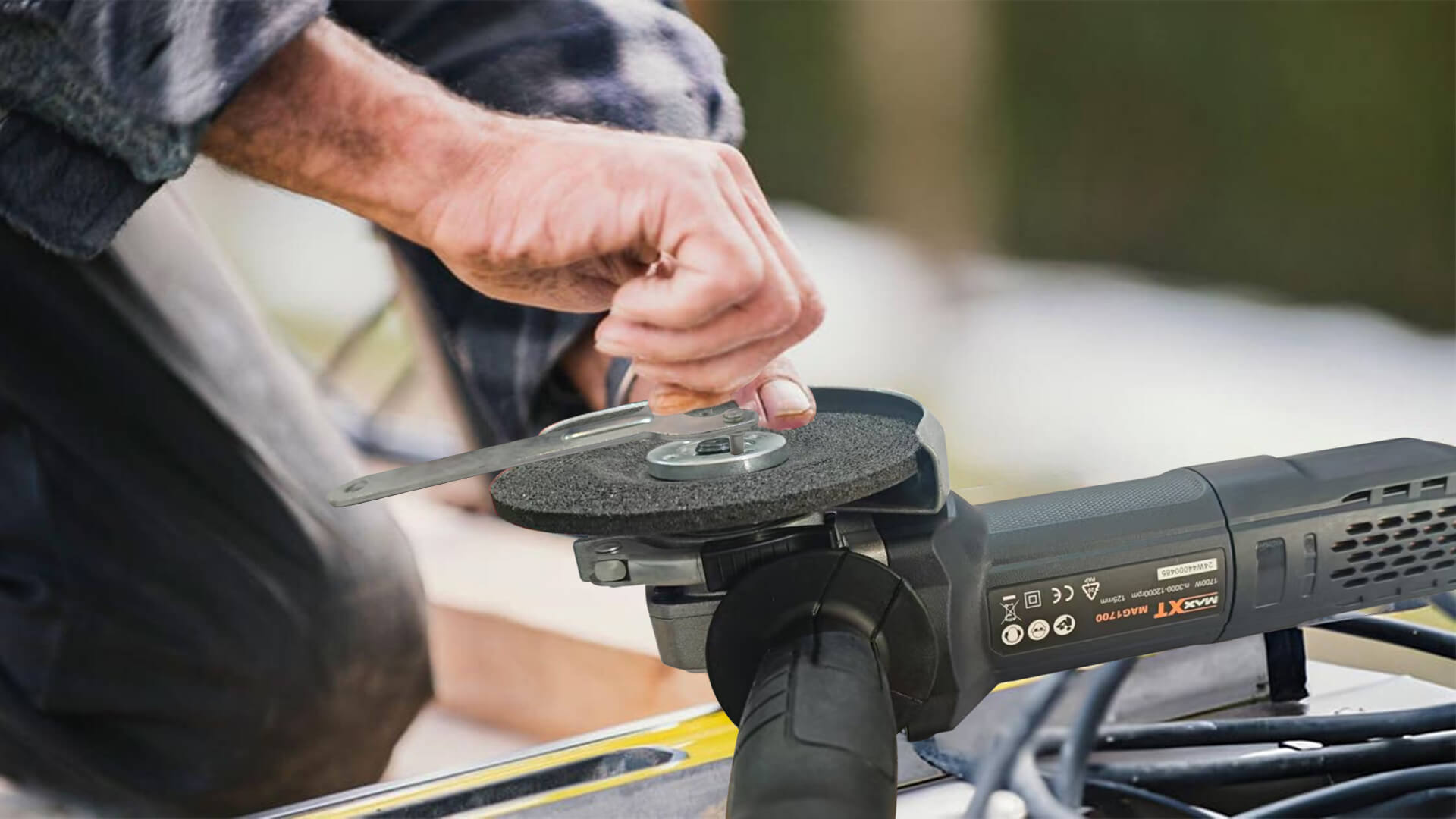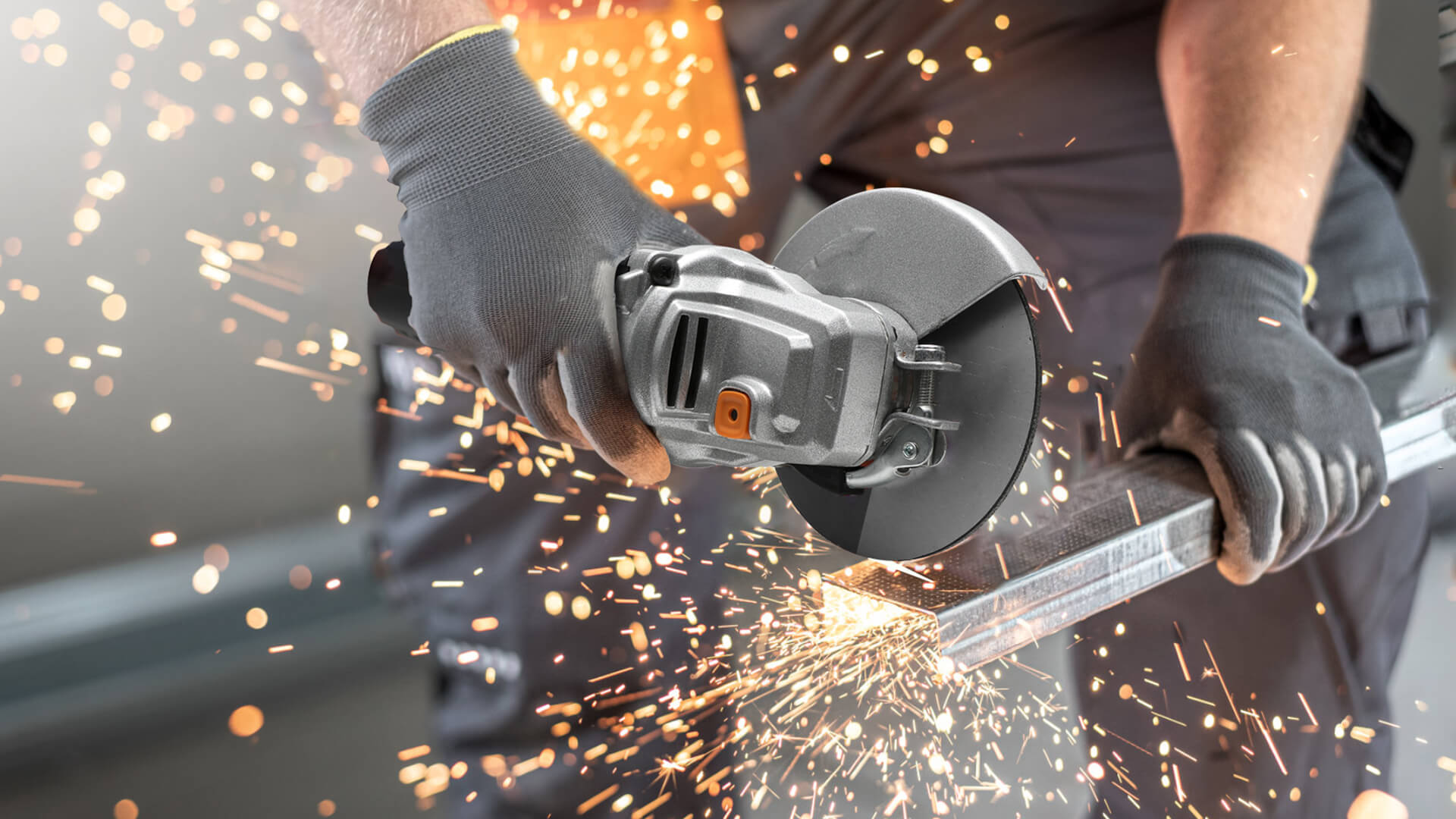Açı taşlama makinesi, kesme, taşlama, parlatma, temizleme ve daha fazlası için kullanılabilen elde taşınabilir bir elektrikli alettir. Çok yönlülüğü tasarımından gelir.
Açı taşlama makinesinin en belirgin kısmı dairesel bıçaktır. Disk veya taşlama çarkı olarak da adlandırılan bu bıçak yüksek hızda döner ve çeşitli işlevler gerçekleştirmenize olanak tanır.
Boyutu uygulamanın ne kadar ince olacağını belirler. Daha büyük bıçaklar malzemeyi kaba bir şekilde kesmenizi ve öğütmenizi sağlarken, daha küçük bıçaklar ince ve hassas kesimler elde etmenizi sağlar.
Aletin kalbi, bu dönen diski çalıştıran motorudur. Genellikle sabit bir hızda çalışır. Dakikada 8.000 ila 11.000 devir (RPM). Ancak, çoğu modern modelde değişken hız ayarı vardır.

Açı taşlama makinesinin diğer bileşenleri şunlardır:
- Mil:Diski tutan ve döndüren motora bağlı parça.
- Koruma: Kullanıcıyı döküntülerden ve kıvılcımlardan korumak için diskin etrafında bulunan koruyucu bir kapak.
- Halletmek: Kavrama ve kontrol sağlar; çoğu açılı taşlama makinesi daha iyi denge için ikincil bir yan sap sunar.
- Tetikleyici/Anahtar: Aleti çalıştırmak ve durdurmak için kullanılır, çoğunlukla bir emniyet kilidi mekanizması vardır.
- Mil Kilidi: Milin yerinde kalmasını sağlayarak disklerin değiştirilmesini kolaylaştıran bir özellik.
Lütfen açılı taşlama makinesinin başka isimlerinin de olduğunu unutmayın. İnsanlar dünyanın farklı yerlerinde açılı taşlama makinesi eş anlamlılarını (disk taşlama makinesi veya yan taşlama aleti) kullanabilir.
Açı Taşlama Makinelerinin Çeşitleri
Açı taşlama makinelerinin iki ana tipi vardır: elektrikli ve pnömatik.
Elektrikli açılı taşlama makinesi elektrikle çalışırken, pnömatik olanı basınçlı hava kullanır. Elektrikli taşlama makineleri genellikle daha az maliyetli ve kullanımı kolay olduğu için tercih edilir.
Herhangi bir yere kurulabilirler ve binadaki en yaygın kaynaklarla çalıştırılabilirler. Ancak, bu tür altında iki alt tür daha bulacaksınız:
Kablolu açılı taşlama makinesi
Bu açılı taşlama makinelerinin işlevsellik için bir prize takılması gereken bir kablosu vardır. Sürekli bir güç kaynağı sağlar, bu da onu daha güvenilir ve kararlı hale getirir. Ancak, kablonun uzunluğu çalışma alanını sınırlayabilir.
Akülü açılı taşlama makinesi
The akülü açılı taşlama makinesi Şarj edilebilir pillerle çalışır. Harika taşınabilirlik ve rahatlık sunar. Projeleriniz üzerinde çalışmak için her yere götürebilirsiniz. Ancak, pille çalışan açılı taşlama makinesinin pil ömrü sınırlıdır.

Bir açılı güç taşlama makinesi seçerken, hedef müşterilerinizin özel ihtiyaçlarını göz önünde bulundurmanız önemlidir. Ev sahibi ve kendin yap meraklısı mı? Evetse, kablosuz bir versiyonunu severler. Karşılaştırmalı olarak, profesyonel inşaat ve metal işçileri kablolu bir model tercih eder.
Açı Taşlama Makinesinin 7 Farklı Kullanımı
Adından da anlaşılacağı gibi, açılı taşlama makinesinin birincil amacı metali taşlamaktır. Bu, kaynak topaklarını, keskin köşeleri ve diğer yüzeyleri içerebilir. Ancak, aşağıdaki görevler için de kullanabilirsiniz:
Pas Temizleme
Pas, metal yüzeylerde gerçekten bir hasara yol açabilir. Ancak tel fırçalı veya kanatlı diskli bir açılı taşlama makineniz varsa, ondan kurtulmak çok daha kolaydır. Tel fırçayı takmanız yeterlidir ve pası kısa sürede temizlemeye hazırsınız.
Dönen kıllar tüm o zorlu noktalara ulaşmada harika bir iş çıkarır. En inatçı pası bile temizler ve altındaki metali eski haline getirir.
Metal Kesme
Metal kesme diski takabilir ve açılı taşlama makinesini kullanarak çelik ve bakır gibi farklı metalleri kolayca kesebilirsiniz. Bu özellikle inşaat veya yenileme çalışmaları için faydalıdır.
Açı taşlama makinesi boruları, çubukları, metal levhaları ve daha fazlasını kesmenize yardımcı olur. Ancak daha kalın metallerle uğraşıyorsanız, pürüzsüz, hassas kesimler elde etmek için birkaç geçiş yapmanız veya daha güçlü bir taşlama makinesi kullanmanız gerekebileceğini unutmayın.

Zımparalama
Bir açılı taşlama makinesi sadece kesmek için değildir – zımparalamak için de harikadır. Pürüzlü yüzeyleri düzeltmek veya metali kaynak için hazırlamak için kullanabilirsiniz.
Ayrıca eski kaplamaları çıkarmak veya metal yüzeyleri yeni bir boya veya cila katmanına hazırlamak için de kullanabilirsiniz. Taşlama makinesinin yüksek hızı sayesinde zımparalama işlemi hızlı ve etkili bir şekilde yapılır.
En iyi sonuçları elde etmek için, çalıştığınız malzemeye uygun doğru kum ve zımpara diskini seçtiğinizden emin olun.
Bileme Aletleri
Aletlerinizi keskin tutmak, iyi çalıştıklarından ve güvenli bir şekilde kullanıldıklarından emin olmak için önemlidir. Bir açılı taşlama makinesiyle, keski, çim biçme makinesi bıçakları ve matkap uçları gibi aletlerin keskinliğini kolayca geri kazanabilirsiniz.
Ancak en iyi sonuçları elde etmek için, özellikle bileme için yapılmış bir taşlama tekerleği kullanın. Ayrıca, keskin bir kenar elde etmek için çalışırken sabit bir açı tutun.
Fayans Kesme
Fayanslarda hassas kesimler yapmak için açılı taşlama makinesi de kullanabilirsiniz. Farklı fayanslarda düz veya kavisli kesimler yapmanıza yardımcı olmak için özel bir elmas bıçak (fayans kesme tekerleği olarak da bilinir) gelir. Seramikten porselene kadar her şeyde işe yarar!
Bu, mutfak ve banyo gibi yerlerdeki fayans projeleri için mükemmel hale getirir. Sadece kesimlerinizi net bir şekilde işaretlediğinizden ve doğru sonuçlar almak için zaman ayırdığınızdan emin olun.
Derz Dolgusu İçin Harcın Çıkarılması
Bu işi yapmak için harç tırmıklama veya derz dolgu bıçağı olan bir açılı taşlama makinesi kullanabilirsiniz. Bu, çevredeki duvar işçiliğine zarar vermeden eski harcı çıkarmanıza yardımcı olur. Sadece aşırı taşlamamaya dikkat edin, böylece yeni harç yüzeye düzgün bir şekilde bağlanabilir.
Beton Kesme
Beton sert bir malzemedir, ancak elmas bıçaklı bir açılı taşlama makinesi işi halledebilir. Beton levhaları, bordürleri veya blokları kesebilir.
Bu kullanım, hassas kesimlerin gerektiği projeler için özellikle değerlidir. En iyi sonuçları elde etmek için, kesme çizginizi net bir şekilde işaretleyin ve sabit bir el kullanın. Daha büyük kesimler veya daha kalın beton için, birkaç geçiş yapmanız veya daha güçlü bir taşlama makinesi kullanmanız gerekebilir.
Açı Taşlama Makinesi Nasıl Güvenli Kullanılır?
Açı taşlama makinesi kullanmak oldukça kolaydır ancak güvenli ve etkili bir çalışma için birkaç temel adımı takip etmeniz gerekir. Bunlar şunları içerir:
Adım 1: Doğru Diski Seçin
Öncelikle, elinizdeki işe uygun bir disk seçmelisiniz. Kesme, taşlama veya cilalama yapmanız fark etmez. Her iş için belirli bir disk gerekecektir.
Bu nedenle, disk üzerindeki etiketi her zaman kontrol ettiğinizden emin olun. Kullanım amacınıza uygun olarak tasarlanmış olmalıdır. Aksi takdirde, açılı taşlama makinesi kötü sonuçlar üretebilir.
Adım 2: Malzemeyi Yerine Sabitleyin
Şimdi, malzemenin sağa sola kaymasını önlemek için onu yerinde sabitlemeniz gerekir. Malzemeyi sıkıca tutmak için kelepçeler veya başka bir şey kullanabilirsiniz. Bu adımı göz ardı etmeyin çünkü sabitlenmemiş bir malzeme üzerinde çalışmak kazalara ve düzensiz sonuçlara neden olabilir.

Adım 3: Diski Takın ve Sabitleyin
Malzemeniz hazır olduğunda, diski açılı taşlama makinesine takmanın zamanı geldi. Diski dikkatlice taşlama makinesinin miline yerleştirin ve sıkın.
Adım 4: Koruma
Şimdi, öğütücünün koruyucusunu kıvılcımlardan, tozdan ve döküntülerden sizi koruyacak şekilde ayarlayın. Koruyucu sizinle üzerinde çalıştığınız malzeme arasında konumlandırılmalıdır.
Ayrıca açılı taşlama makinesi tehlikeli olabilir. Bu nedenle, her zaman güvenlik gözlüğü, eldiven ve toz maskesi gibi koruyucu ekipman takmalısınız. Bu sizi uçan döküntülerden, kıvılcımlardan ve zararlı toz parçacıklarından koruyacaktır.
Adım 5: Öğütücüyü Güçlendirin
Hazır olduğunda, öğütücüyü açın ve tam hıza ulaşmasını bekleyin. Çok erken başlamanın öğütücünün beklenmedik şekilde sarsılmasına neden olabileceğini unutmayın.
Adım 6: Sabit Basınç Uygulayın
Çalışırken, öğütücüyü yüzey üzerinde hareket ettirirken sabit ve eşit basınç uygulayın. Sertçe bastırmanıza gerek yok çünkü öğütücünün hızı ve diski işi halledecektir.
Adım 7: Öğütücüyü Güvenli Şekilde Kapatın
İşiniz bittiğinde, öğütücüyü kapatın ve yerine koymadan önce diskin tamamen durmasını bekleyin. Disk hala dönerken asla yere koymayın, aksi takdirde hasara neden olabilir. Çalışma alanında kalan kalıntıları ve tozu temizleyin.
Açı Taşlama Makinesi Bıçağı Nasıl Değiştirilir?
Açılı taşlama makinesinin nasıl kullanılacağını öğrendiğimize göre, bir diğer önemli işlem olan bıçak değiştirme işlemine de değinelim!
Bu oldukça basittir ve kısa sürede bitireceksiniz. Sadece önce öğütücünün fişini çekmek veya kablosuzsa pili çıkarmak gibi birkaç güvenlik adımı attığınızdan emin olun.
Güvenli olduğunda, öğütücüyü sabit, düz bir yüzeye koyun. Bıçağın hareket etmesini önlemek için mil kilidi düğmesine basın, bu sayede değiştirme işlemi daha kolay olur.
Somunu gevşetmek için bir anahtar kullanın. Gevşedikten sonra bıçağı çıkarın ve herhangi bir hasar olup olmadığını inceleyin. Şimdi, yeni bıçağı takın ve her şeyin güvenli ve düzgün bir şekilde takıldığından emin olun.
Mil kilidini serbest bırakın, öğütücüyü tekrar takın veya pili yeniden takın. Her şeyin düzgün çalıştığından emin olmak için hızlı bir test çalıştırması yapın ve işiniz bitti!

Açı Taşlama Makinesinin Bakımı İçin İpuçları!
Açı taşlama makineleri uzun süre dayanacak şekilde tasarlanmış sağlam aletlerdir. Ancak düzenli olarak kullanıyorsanız, sorunsuz çalışmasını sağlamak isteyeceksiniz. İşte yardımcı olacak basit ipuçları:
- Aşırı ısınmaya yol açabilecek birikmeleri önlemek için her kullanımdan sonra toz ve kalıntıları temizleyin.
- Bıçakları sık sık kontrol edin ve çatlamış veya aşınmış olanları değiştirin.
- Sürtünmeyi, aşınmayı ve ısıyı azaltmak için hareketli parçaları yağlayın.
- Kablolu modellerde, güç kablosunda herhangi bir hasar olup olmadığını kontrol edin ve elektrik sorunlarını önlemek için yıpranmış veya açıkta kalan kabloları hemen değiştirin.

SSS
Açı Taşlama Makineleri Ne İçin En İyisidir?
Açı taşlama makineleri metal, beton ve taş kesmek, taşlamak ve parlatmak için harika araçlardır. İnanılmaz derecede çok yönlüdürler ve her türlü işi halledebilirler.
Açı Taşlama Makinesi ile Biçme Makinesi Bıçakları Nasıl Bilenir?
Öncelikle bıçağı bir mengeneye sıkıca sabitleyin, ardından üreticinin önerdiği açıda bilemek için bir taşlama tekerleği kullanın. Eşit bir kenar elde etmek için, taşlama makinesini bıçak boyunca sabit bir şekilde hareket ettirdiğinizden emin olun.
Açı Taşlama Makinesiyle Zımparalama Yapılabilir mi?
Evet, bir flap disk veya zımpara pedi takarak zımparalama için açılı taşlama makinesi kullanabilirsiniz. Bu, yüzeyleri düzeltmeyi, boyayı soymayı veya bitirme için malzemeleri hazırlamayı kolaylaştırır.
Gitmeden Önce!
Sonuç olarak, açılı taşlama makinesi herkesin alet çantasına güçlü bir ektir. Hem profesyoneller hem de amatörler bu aleti çeşitli malzemeleri kesmek, rafine etmek ve keskinleştirmek için kullanabilirler. Ancak, uygun bakım yapılmazsa performansı düşebilir.
Bu nedenle, uzun ömürlü performans sağlamak için açılı taşlama makinenizi korumak ve güvenli kullanım uygulamalarını takip etmek önemlidir. Bu ipuçlarını müşterilerinize önermek, aletlerinden en iyi şekilde yararlanmalarına yardımcı olabilir.
Güvenilir, yüksek performanslı seçenekler arayanlar için, Maxxt Toptan Satış dayanıklı açılı taşlama makineleri yelpazesi sunar.
Araçlarımıza sektörler genelindeki profesyoneller güvenmektedir. Dolayısıyla, müşterilerine en iyisini sunmak isteyen bir bayi veya marka sahibiyseniz, bugün ortaklığımıza katılın. Pazarınıza birinci sınıf ürünler sunarak birlikte büyüyelim!
